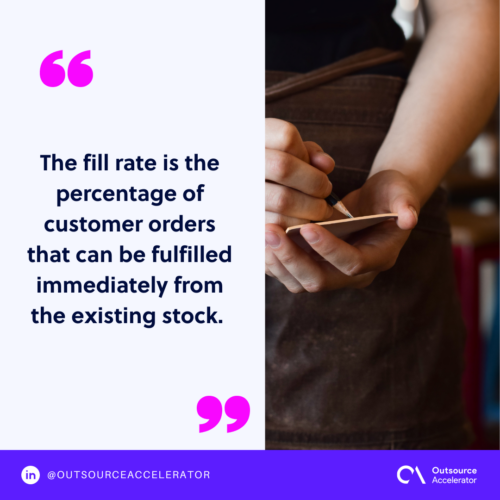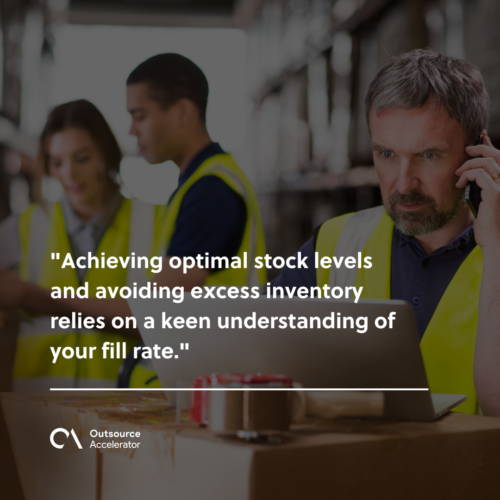Fill rate: Definition, types, and calculation

Efficiency is the name of the game. For business owners, ensuring that operations run smoothly and products reach customers on time is vital.
One often overlooked metric that plays a pivotal role is the fill rate.
In this article, we’ll delve into the definition, types, calculation, and importance of fill rate.
What is the fill rate?
The fill rate is the percentage of customer orders that can be fulfilled immediately from the existing stock. It’s a key performance indicator that provides insights into how well a company meets customer demand without delays or backorders.
Calculating the fill rate helps businesses avoid such pitfalls and guarantees smoother operations.

6 types of fill rates
Understanding these types of fill rates is essential for optimizing operations and customer satisfaction. Here are some important categories:
1. Inventory fill rate
This fill rate variant evaluates a company’s ability to satisfy customer demand using its current inventory.
It gives you information on the overall health of your stock levels and helps you avoid overstocking or stockouts.
2. Order fill rate
An order fill rate is all about fulfilling complete customer orders. It evaluates the percentage of orders that are shipped without any backorders or missing items.
A high order fill rate indicates effectiveness in order processing and customer satisfaction.
3. Line fill rate
Line fill rate zooms in on individual product lines within an order. It measures the percentage of items that are shipped without any issues.
Line fill rate is particularly useful for businesses with diverse product offerings.
4. On-time fill rate
Timing is everything. An on-time fill rate evaluates how often orders are delivered within the promised timeframe.
This metric is crucial for meeting customer expectations and maintaining a positive brand image.
5. Back-order fill rate
When items are out of stock but promised to customers at a later date, the backorder fill rate becomes vital.
It measures the percentage of back-ordered items that are successfully fulfilled when they become available.
6. Vendor fill rate
Effective collaboration with suppliers is crucial in the supply chain. A vendor fill rate evaluates the ability of your suppliers to meet your demand, ensuring a seamless and dependable flow of goods.

How to calculate a fill rate
Now that we’ve recognized the types fill rate, let’s break down the steps to calculate this metric:
Determine the number of units shipped
To begin, calculate the total number of units that have been successfully shipped to customers during a specific period.
Include all products that have left your inventory and reached their intended destination. This figure represents the actual units fulfilled by your supply chain.
Determine the number of units ordered
Next, calculate the total number of units that customers have ordered within the same time frame. Include all orders, regardless of whether they have been fulfilled or are still pending.
Apply the formula
With the numbers in hand, calculating the fill rate involves a straightforward formula:
Fill rate = (number of units shipped/number of units ordered) × 100
Express the result as a percentage to gauge how effectively your business meets customer demand.
By following these steps and using the fill rate formula, you can quantitatively assess your supply chain’s performance.
A higher fill rate percentage indicates a more efficient and reliable supply chain. It means contributing to customer satisfaction and overall business success.
Importance of understanding a fill rate
Let’s explore the key reasons why comprehending a fill rate is crucial:
Customer satisfaction
Maintaining a high fill rate is synonymous with meeting customer expectations.
When orders are fulfilled promptly and accurately, customers are not only satisfied but are probably to become repeat buyers.
Optimized inventory management
An efficient fill rate is a direct reflection of optimized inventory management. Achieving optimal stock levels and avoiding excess inventory relies on a keen understanding of your fill rate.
By aligning your inventory with actual customer demand, you can minimize carrying costs while ensuring products are readily available when needed.

Minimized stockouts
Low fill rates often result in stockouts – a situation where products are not available when customers want to purchase them.
Understanding and actively managing your fill rate:
- Helps minimize the occurrence of stockouts
- Prevent lost sales and customer frustration
Consistent availability of products fosters a positive perception of your business’s reliability.
Supplier relationships
A fill rate isn’t solely an internal metric; it also impacts your relationships with suppliers. By monitoring and improving your fill rate, you contribute to a smoother and more predictable supply chain.
Reliable order fulfillment creates a positive feedback loop with suppliers, leading to stronger partnerships and better negotiating positions.
Forecast accuracy
Accurate forecasting is a cornerstone of successful supply chain management. Understanding your fill rate provides valuable insights into demand patterns and customer behavior.
How do we increase the order fill rate?
Improving your order fill rate involves a combination of the following:
- Strategic planning
- Streamlined processes
- Effective communication with suppliers and customers
- Optimizing your inventory
- Enhancing order processing efficiency
- Implementing advanced forecasting techniques
A fill rate is more than just a metric – it’s a reflection of your supply chain’s health and its impact on customer satisfaction.
By understanding, calculating, and actively working to improve your fill rate, you’re not just managing inventory; you’re optimizing your business for success.







 Independent
Independent




